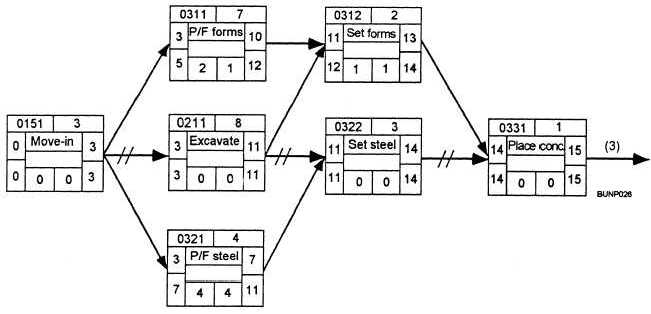Late Finish - Duration = Late Start
Late Start - Lag (if any) = Late Finish (preceding activity)
TOTAL FLOAT. - Total float is the number of days an activity can be delayed without delaying the project completion date. Looking at activity 0311 in figure 2-31, you see that it could finish as early as day 10 or as late as day 12. The 2 days of leeway between day 10 and day 12 inactivity 0311 are called total float. To calculate the total float, you subtract the early finish date from the late finish date or the early start date from the late start date. The numbers will be the same. If not, you made a math error.
Total Float = Late Start - Early Start (or Late
Finish - Early Finish)
FREE FLOAT. - Free float is the number of days an activity can be delayed without taking float away from the next activity. Another way of saying the same thing is that free float is the number of days an activity can be delayed without delaying the early start date of the next activity. To calculate the free float for an activity, you subtract any lagtime and the early finish for the activity from the early start for the next activity. To calculate the free float for activity 0311 in figure 2-31, you would take the early start for activity 0312, subtract any lagtime between 1020 and 1050 (zero in this case), and subtract the early finish for activity 0311 (11 - O - 10 = 1). Free float for activity 0311 is 1 day. You can see that delaying activity 0311 by 1 day will not delay activity 0312 from its early start date. Delaying activity 0311 by 2 days will delay the start of activity 0312 until day 12 and reduce the float for activity 0312 by 1 day (to zero, in this case). The delay of activity 0311 by more than 2 days will delay the project completion date because 0311 has only 2 days of total float.
Free Float = Early Start (next activity)
- Lagtime (if any) - Early Finish
CRITICAL PATH. - Looking at activity 0311 in figure 2-31, you could start that activity as early as day 3 or as late as day 5. Now subtract 3 from 5 and enter 2 days as the total float. Where the early start and late start are the same, there is no float. "No float" means you have to start that activity on its early start date. It cannot be delayed without delaying the project completion date. Activities with no float are said to be critical.
The first and last activities will always be critical, and there will be a critical path of activities between them. The critical path in figure 2-31, is 0151-0211-0322-0331. The critical path allows management to focus attention on those activities that cannot slip.
Advantages of Diagrams
Precedence networks are easy to draw because all the activities can be placed on small cards, laid out on a flat surface, and easily manipulated until a logical sequence is achieved. It is also easy to show the interrelationships and forward progress of the activities. Just draw connector lines. Figure 2-32

Figure 2-31. - Logic network.
Continue Reading